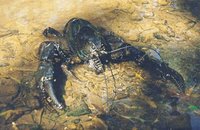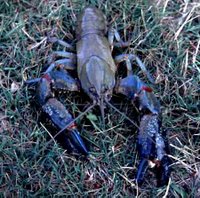Dear Blue Lobster:
Our blue crayfish is about 4" long (from end of tail to tip of pinchers). She went through a molt about 4 weeks ago and was her normal self until last week. She seems to lay about for long periods of time and does not seem to be interested in eating. The water checks out as being healthy. There are quite a few water plants in this 10 gallon tank. Any guesses as to what the problem might be?
Thank you.
Dear Gentle Sir:
After eliminating water quality and environment, it sounds like your crayfish has the Winter Blues, also known as Seasonal Affective Disorder (SAD). This ailment is brought about when certain chemicals in the brain, dependent upon exposure to natural sunlight, are secreted less frequently than needed. The result is depression that begins in the Autumn and intensifies throughout the Winter.
Crustaceans in temperate and arctic environs show increased depression during periods of the year with shorter days, and during these times crayfish suicide is not uncommon. Scandinavia and Alaska, where there may not be sun for weeks or months at a time, have the highest cray-suicide rates of anywhere in the world; however, any case of SAD, no matter its location, is a serious one. Thankfully, there are many treatments today that range from light therapy to counseling to medication.
One of the first things a cray-caretaker should do is make sure there are a variety of activities for the cray. Are there plenty of caves and tunnels for your chitonous friend to explore? Perhaps a hamster wheel or a pack of wily ghost shrimp might be in order to keep your cray's metabolism up. Exercise is usually a successful treatment for depression, with 67% of crayfish, and 58% of all decapods, reporting an increase in energy and mood after just one month of 30 minutes daily exercise.
The addition of special bulbs to your aquarium setup can help mimic the natural UV rays of the sun that a cray would enjoy in the summer months. Though more expensive, they not only energize the mood of your tank but also help clear up gill flukes, shell infections, and acne. Should the cost of such light prove prohibitive, however, a weekly trip to your local tanning salon will do. Simply set your cray in a tanning bed for the maximum time limit. Be sure to ask your tanning salon clerk about discounts for crustaceans!
Another folk remedy is to pour one cup of coffee into your cray's tank every morning. Used as a trick by trappers trying to capture sluggish crays, the caffeine stimulates the cray's heart rate and blood pressure. Include a teaspoon or more of sugar for an added kick, but be ready to clean the tank: As with humans, caffeine acts as a stimulant to the lower bowel system and your cray will expel an unbelievable amount of feces soon after he's had his morning cup. Keep that scrubber handy!
Should the above home remedies not produce improvements in your cray's health, seek professional help. Regular counseling with a psychologist might be necessary, and certain prescription drugs are available to your cray as well. Prozac, Zoloft, and Paxil have all shown great promise in mood normalization for many crayfish mental health problems including bipolar disorder, anxiety disorder, clinical depression, and seasonal affective disorder.
With time, patience, and perhaps medical care, your cray should his creepy-crawly self in no time at all.



